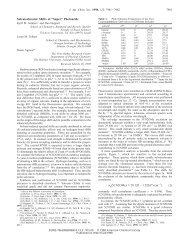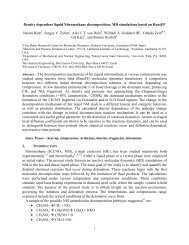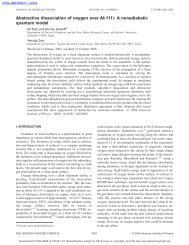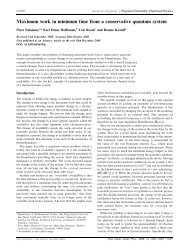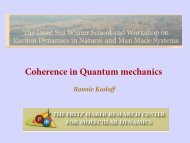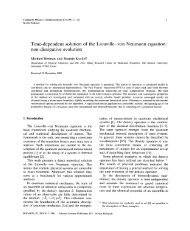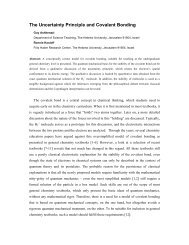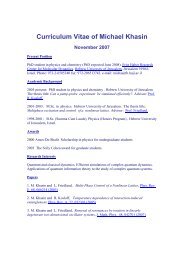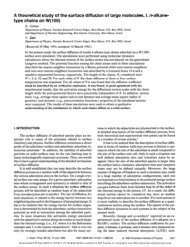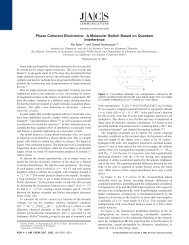Molecular Symmetry Properties of Conical Intersections and ...
Molecular Symmetry Properties of Conical Intersections and ...
Molecular Symmetry Properties of Conical Intersections and ...
Create successful ePaper yourself
Turn your PDF publications into a flip-book with our unique Google optimized e-Paper software.
3008 J. Phys. Chem. A, Vol. 114, No. 9, 2010 Al-Jabour et al.<br />
MS property <strong>of</strong> the IREPs, together with theorem 15, implies<br />
that, in practice, it suffices to determine the IREPs <strong>of</strong> the NACT<br />
τk i,j (s) with respect to a single symmetry-adapted coordinate sk;<br />
this implies the IREPs <strong>of</strong> all other τl i,j (s), for all coordinates s.<br />
The general theory <strong>and</strong> the resulting recipes for constructions<br />
<strong>of</strong> the NACTs <strong>and</strong> CIs with the proper IREPs in global domains,<br />
e.g., for torsional motions from the molecular syn to the anti<br />
isomer, have been demonstrated in detail for the simple model<br />
C5H4NH which has MS symmetry C2V(M). The step-by-step<br />
approach should serve as an example for extended applications<br />
to more dem<strong>and</strong>ing systems. The results are summarized in<br />
Table 1 as well as several figures. Some <strong>of</strong> the underlying tools<br />
which have been developed or integrated in the individual steps<br />
appear to be quite powerful. For example, the localization <strong>of</strong><br />
the “first” CI1 0,1 at the perpendicular geometry ( 0,1 ) π/2) has<br />
been achieved by means <strong>of</strong> the method based on the Longuet-<br />
Higgins theorem. 33 This requires nothing but quantum chemistry<br />
calculations <strong>of</strong> four “anchors” (the potential minima <strong>and</strong> two<br />
transition states) <strong>of</strong> C5H4NH in the electronic ground state S0.<br />
Nevertheless, this rather restricted “input” from quantum<br />
chemistry, combined with the general results for the MS group,<br />
suffices in order to determine the global IREPs <strong>of</strong> all <strong>of</strong> the<br />
NACTs τk 0,1 for the couplings <strong>of</strong> the PES <strong>of</strong> the electronic ground<br />
state V0 <strong>and</strong> the excited state V1, including all <strong>of</strong> the MS<br />
properties such as the nodal patterns <strong>and</strong> the signs <strong>of</strong> the NACTs<br />
or the opposite charges <strong>of</strong> the MS-adapted set <strong>of</strong> the two CI1 0,1<br />
<strong>and</strong> CI2 0,1 , <strong>and</strong> even the fact that the seam <strong>of</strong> CI 0,1 in the<br />
(r, )-plane is restricted to the orthogonal geometry, without<br />
any neccessity <strong>of</strong> calculating V1 or the τk 0,1 explicitly!<br />
These <strong>and</strong> other, rather rich results for all <strong>of</strong> the NACTs <strong>and</strong><br />
the CIs <strong>of</strong> the three lowest electronic singlet states S1, S1, <strong>and</strong><br />
S2 <strong>of</strong> C5H4NH have been confirmed by various tests for selfconsistency.<br />
In particlar, we have calculated the A matrices for<br />
adiabatic-to-diabatic transformation, based on the MS-adapted<br />
NACTs, along different paths for molecular torsion. In the limit<br />
<strong>of</strong> torsion by 2π (360°), the A matrices approach the so-called<br />
topological matrices D which have to satisfy simple but<br />
m<strong>and</strong>atory quantization rules; i.e., they must be diagonal, with<br />
diagonal elements equal to 1 or -1 where the number <strong>of</strong> -1’s<br />
must be even. 1 We consider the successful computational tests<br />
<strong>of</strong> this dem<strong>and</strong>ing rule as rewarding. Turning the table, the selfconsistency<br />
tests could also be employed as alternative criteria<br />
for the determination <strong>of</strong> the IREPs; e.g., we could have used<br />
the information for the nodal patterns <strong>of</strong> the radial NACTs<br />
(Figure 7) instead <strong>of</strong> the switching property (Figure 6a); see<br />
the discusions in section III.<br />
The present combination <strong>of</strong> quantum chemistry beyond<br />
Born-Oppenheimer <strong>and</strong> the molecular symmetry group suggests<br />
several extensions. First, the two fields should be combined with<br />
a third one, i.e., quantum reaction dynamics. The solutions <strong>of</strong><br />
the corresponding time dependent Schrödinger equation, i.e.,<br />
the representative wavepackets which are propagated on several<br />
coupled PES, depend on the couplings <strong>of</strong> the PES, i.e., on the<br />
NACTs. As a working hypothesis, these results should depend<br />
on the IREPs <strong>of</strong> the NACTs, in the frame <strong>of</strong> the MS group, if<br />
the wavepackets evolve from one molecular domain to different<br />
MS-adapted ones, e.g., due to large amplitude motions such as<br />
torsion or isomerization. For reference, effects <strong>of</strong> the MS group<br />
on the quantum reaction dynamics have been demonstrated<br />
previously, e.g., for laser separation <strong>of</strong> nuclear spin isomers, 45,46<br />
but so far without explicit consideration <strong>of</strong> MS effects on the<br />
NACTs. Concerning the methodology, these quantum simulations<br />
should be carried out using the so-called diabatic representation,<br />
which is much more convenient than the adiabatic one. 1,2,28 It is<br />
gratifying that the present approach already provides the A matrix<br />
for the underlying adiabatic-to-diabatic transformation <strong>of</strong> the PES,<br />
based on the NACTs with proper IREPs. Second, we have<br />
implicitly assumed that the molecule is in the rotational ground<br />
state; this allowed us to use the MS-adapted torsional angle which<br />
describes the rotation <strong>of</strong> the light hydrogen atom <strong>of</strong> the NH bond<br />
relative to the heavy C5H4N fragment. For more general scenarios,<br />
the present approach should be extended to the theory <strong>of</strong> double<br />
groups. 47,48 Last but not least, it is a challenge to extend the present<br />
development to additional MS-adapted coordinates, <strong>and</strong> to molecules<br />
with more dem<strong>and</strong>ing MS groups, including groups with<br />
larger orders, <strong>and</strong> also with two- or more-dimensional IREPs; there<br />
are actually many systems in the literature which call for such<br />
extended investigations; see, e.g., refs 49 <strong>and</strong> 50. Work along these<br />
lines is in progress.<br />
Acknowledgment. We thank Pr<strong>of</strong>. Lluis Blancafort, Pr<strong>of</strong>.<br />
Dietrich Haase, Pr<strong>of</strong>. Yehuda Haas, PD Dr. Dirk Andrae, Mr.<br />
Thomas Grohmann, <strong>and</strong> Ms. Shireen Alfalah for advice <strong>and</strong><br />
stimulating discussions, <strong>and</strong> Mr. Dominik Sattler for preparing<br />
Figures 1 <strong>and</strong> 2. This study was supported by the Deutsche<br />
Forschungsgemeinschaft in the framework <strong>of</strong> Project No. MA<br />
515/22-2, <strong>and</strong> by Fonds der Chemischen Industrie.<br />
Appendix<br />
This Appendix considers the second example <strong>of</strong> section II,<br />
items vii <strong>and</strong> viii, in terms <strong>of</strong> symmetry-adapted Cartesian<br />
coordinates s ){x, y}, complementary to cylindrical coordinates<br />
s ) {r, }. The scenario assumes that the first CI1 i,i+1 has been<br />
discovered at [si,i+1 ]1 ) [{xi,i+1 , yi,i+1 }]1 ) {x, 0}. Application<br />
<strong>of</strong> the molecular symmetry operator (12)* generates the second<br />
CI2 i,i+1 at [{x, y ) 0}]2 ){-x, 0}; see Figure 9. Here, we present<br />
a “shortcut” derivation <strong>of</strong> the opposite charges <strong>of</strong> CI1 i,i+1 <strong>and</strong><br />
CI2 i,i+1 , implying the IREP B2 <strong>of</strong> CIi,i+1 , in accord with Table 1.<br />
For convenience, we use a simplified notation, by dropping<br />
many sub- or superscripts which the reader could add in accord<br />
with the rest <strong>of</strong> the paper.<br />
A. Two (Symmetric) Two-State <strong>Conical</strong> <strong>Intersections</strong> in<br />
a Plane. We consider two two-state conical intersections, C1<br />
<strong>and</strong> C2, located in a plane (see Figure 9). In addition, we<br />
distinguish between three regions: ΛI, ΛII, <strong>and</strong> Λ0. Here, ΛI is<br />
defined in terms <strong>of</strong> the closed contour LI <strong>and</strong> contains the conical<br />
intersection C1, ΛII is defined in terms <strong>of</strong> the closed contour LII<br />
<strong>and</strong> contains the conical intersection C2, <strong>and</strong> Λ0 is defined in<br />
terms <strong>of</strong> the closed contour L0 <strong>and</strong> does not contain any ci. Next,<br />
for the sake <strong>of</strong> convenience, we assume all three contours to be<br />
rectangles. Consequently, we employ Cartesian coordinates: x<br />
<strong>and</strong> y (see Figure 9). Please note that the y-axis is defined along<br />
the line <strong>of</strong> symmetry. In what follows, we consider the twostate<br />
case <strong>and</strong> consequently concentrate on the following line<br />
Figure 9. Two molecular-symmetry-adapted conical intersections C1<br />
<strong>and</strong> C2 with the domains ΛI <strong>and</strong> ΛII encircled by closed loops LI <strong>and</strong><br />
LII (continuous lines), respectively. The central domain Λ0 surrounded<br />
by loop L0 (dashed line) does not contain any CI. The arrows indicate<br />
the directions <strong>of</strong> integration for the corresponding contour integrals<br />
which are used to determine the charges <strong>of</strong> the conical intersections;<br />
see text.



